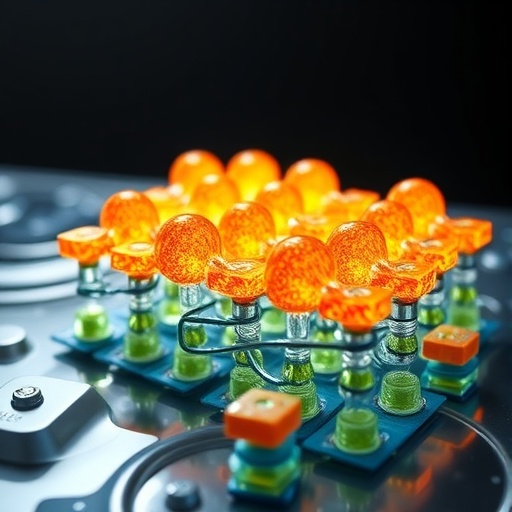In a groundbreaking study that is set to revolutionize the field of electrocatalysis, researchers led by L. Zhu at [Your University] have pioneered the construction of phosphide heterostructures aimed at significantly enhancing the efficiency of seawater oxidation processes. This innovative approach not only has far-reaching implications for energy conversion technologies but also addresses pressing environmental issues related to sustainable energy solutions.
The research, published in the esteemed journal Ionics, presents phosphide heterostructures as a novel material configuration that can enhance the electrocatalytic activity towards seawater oxidation. Seawater oxidation is a critical step in producing clean hydrogen fuel through water electrolysis, a process that has gained momentum due to the increasing demand for renewable energy sources. The team’s investigations reveal that the unique properties of phosphide heterostructures can facilitate this chemical reaction more efficiently than conventional materials.
At the core of this research is the innovative design of phosphide heterostructures, which combine different phosphide materials at the nanoscale. This complex design enables synergistic interactions between the different components, leading to enhanced electron transfer kinetics and improved surface active sites for catalysis. The combination of various phosphide materials opens up new avenues for tuning the electronic properties, optimizing the electrochemical performance, and tailoring the heterostructures for specific applications in seawater oxidation.
The potential for these materials transcends laboratory-scale applications, as they could be integrated into real-world energy systems. With the world’s continuous search for sustainable energy sources, the enhancement of seawater oxidation through optimized electrocatalysts is crucial. The researchers have highlighted how phosphide heterostructures could lead to lower overpotentials and consequently, reduced energy consumption during the electrolytic hydrogen production process.
In the study, Zhu and colleagues employed advanced characterization techniques to verify the structural and electrochemical properties of the constructed phosphide heterostructures. Scanning electron microscopy (SEM) and transmission electron microscopy (TEM) were utilized to visualize the nanostructures. Furthermore, electrochemical testing confirmed their exceptional electrocatalytic performance, underscoring the materials’ practical viability in real-world applications.
As global energy demands rise and the need for sustainable alternatives becomes more pressing, the findings of this research could spur further advancements in electrolysis technology. Driving the shift from fossil fuels to renewable energy sources necessitates improved electrocatalysts that can efficiently facilitate the necessary reactions. The ability to harness seawater, a nearly limitless resource, dramatically alters the landscape for green hydrogen production.
One of the significant advantages of phosphide heterostructures is their ability to operate in saline environments, such as oceans. Traditional catalysts often struggle with stability and performance in such conditions, leading to concerns about the longevity and efficiency of electrocatalytic systems. This research offers promising solutions by demonstrating that phosphide heterostructures can maintain their integrity and performance in harsh seawater conditions.
The findings not only elevate the potential for phosphide heterostructures in electrochemical applications but also open up an extensive field of study regarding their synthesis and scalability. The versatility of the heterostructures invites further exploration into how they can be mass-produced, ensuring that future applications are both economically viable and environmentally sustainable.
Moreover, the interdisciplinary nature of this research underlines the collaboration between material scientists, chemists, and engineers to address multifaceted challenges in energy production. Such teamwork is vital for translating exciting scientific discoveries into practical applications that can positively impact society and the environment.
As this research gains attention, it inspires a dialogue about the future of renewable energy technologies and how cutting-edge materials can be employed to tackle the energy crisis. The implications of these findings could be foundational, paving the way for new standards in the industry. Researchers are now encouraged to build upon these insights, prompting a wave of innovation in the synthesis of heterostructured materials that could soon lead to commercial products.
Engaging with stakeholders in the energy sector, the authors of the study advocate for the accelerated development of these phosphide heterostructures into functional devices. Emphasizing the significance of public-private partnerships, they express optimism that collaborative efforts will facilitate the transition towards sustainable energy systems.
In conclusion, Zhu et al.’s research into phosphide heterostructures for enhanced electrocatalytic seawater oxidation signifies a monumental leap forward in electrochemistry and renewable energy technologies. As scientists continue to explore the potential of these multifaceted materials, the promise of cleaner hydrogen production from seawater becomes an achievable goal. Thus, the work underscores not only the possibilities of advanced materials in the drive for renewable energy but also the urgency surrounding innovations that can meet the world’s growing clean energy demands.
Subject of Research: Enhanced electrocatalytic seawater oxidation using phosphide heterostructures.
Article Title: Construction of phosphide heterostructures for enhanced electrocatalytic seawater oxidation.
Article References: Zhu, L., Li, Z., Liu, L. et al. Construction of phosphide heterostructures for enhanced electrocatalytic seawater oxidation. Ionics (2025). https://doi.org/10.1007/s11581-025-06769-1
Image Credits: AI Generated
DOI: https://doi.org/10.1007/s11581-025-06769-1
Keywords: Electrocatalysis, Phosphide heterostructures, Seawater oxidation, Renewable energy, Hydrogen production.




